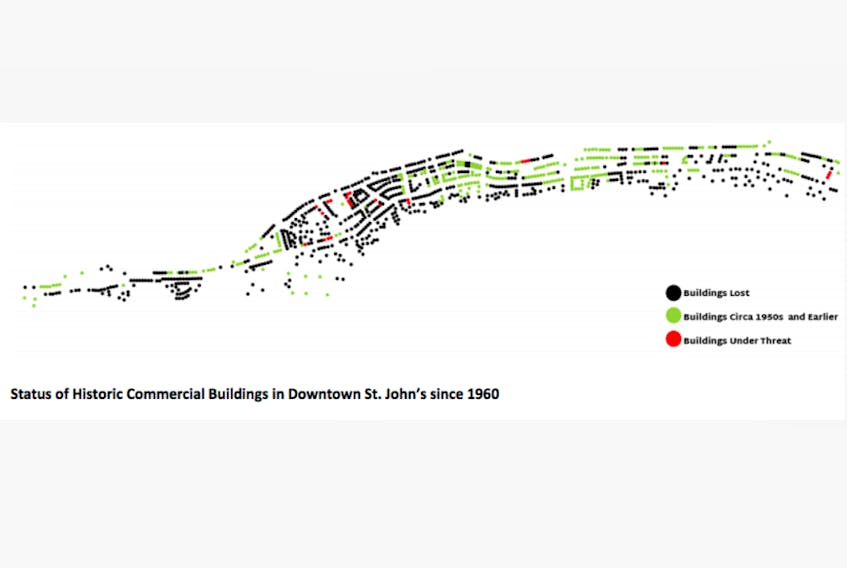ST. JOHN'S, N.L. — Heritage NL has mapped all of the 19th- and early 20th-century commercial buildings in downtown St. John’s that have been lost since 1960, and more than half of the buildings are gone.
“We’re gradually just fragmenting the heritage we have left,” Heritage NL executive director Jerry Dick said.
At a committee of the whole meeting of St. John’s city council this week, Dick made a presentation to council about the impact of development on downtown heritage.
“One decision by the city at a time, we either support or take away from our heritage,” he told The Telegram after the meeting.
Since the 1960s, St. John’s lost the harbourfront finger piers and associated structures due to the construction of Harbour Drive.

The container port replaced all 19th-century buildings on the south side of Water Street from Waldegrave Street to the former train station.
The Pitts Memorial Drive viaduct and creation of New Gower Street removed many 19th- and 20th-century commercial buildings around Gower Street.
Dick says the organization is not advocating the city remain stuck in the past, but rather new developments should reflect both our time and place.
He gave the example of a proposed retail and office building for the corner of Water Street and Bishop’s Cove.
“That building could be anywhere. It doesn’t speak to where it is — Water Street beside a national heritage district.”
Heritage NL made six suggestions for council to encourage what it calls “good new development” in historic districts, outlined in a document provided to councillors.
First, new development is best when it doesn’t provide a false sense of history, but rather is “of this time and of this place,” Heritage NL says.
The organization suggests proponents of new developments submit an analysis of their site to show how the development addresses the cultural, historical and environmental context.
Council development lead Coun. Maggie Burton said she is concerned the city is seeing more buildings that are contemporary, but do not reflect place.
“We have so little authority,” she said, unless a building is a designated heritage building.
“How do we bring design guidelines to an enforceable level?”
Burton said she hopes the Urban and Rural Planning Act will come up for discussion in council so members can think about how to make changes, such as a provincial amendment.
Meanwhile, she is working with a heritage policy working group to identify at-risk buildings, and will soon have recommendations from that group to bring to council.
Cars cause heritage erosion
Heritage NL is also critical of what cars have done to heritage structures.
“What’s really led to much of the erosion of the heritage fabric downtown since the 1960s is accommodating cars,” said Dick.
“And we’re still doing it.”

He said accommodating pedestrians and enhancing public transportation will likely do more to enliven the downtown core than building parking garages.
Another recommendation Heritage NL made to council is early public engagement for new developments.
The Heritage NL document discusses how proposals for public input typically happen late in the design process, when developers are already invested in their concepts.
“The recent submission for an annex to the Anglican Church Cathedral is a case in point. Early public/stakeholder input could have helped shape the way the diocese met their needs in a way that would garner a high level of public acceptance,” reads the document.
Burton said she is speaking with city planning staff to figure out what the city can change to improve engagement.
Dick said he got the feeling from council during his presentation that they want to preserve the heritage fabric of the downtown.
“The question is, how you get there, and I think there’s a little bit of tension – well, just how far can the city go in being proactive and saying, well, this is what we’d like to see? Or, telling developers what to do.
“I think there’s always a fear that maybe the developer will back off, but I would argue that it might be better to have a vacant lot vacant for another couple of years until the right proposal comes along, than what might be a poor proposal, because I say good development can reinforce a neighbourhood, (but) poor development can really strangle it and kill it.”
Twitter: @juanitamercer_
Related









